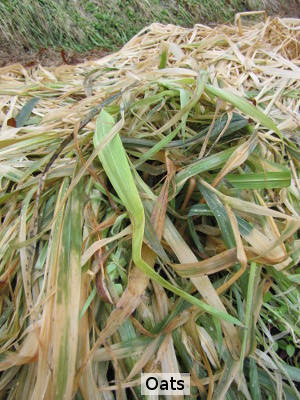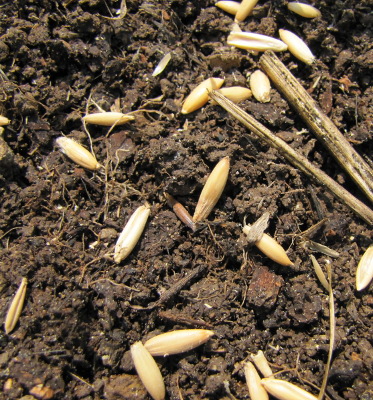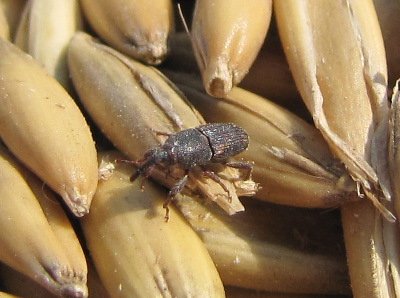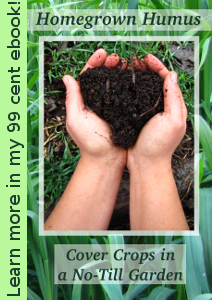
Grow your own straw mulch
 So
you want to mulch your garden to keep weeds at bay all winter, but
storebought mulch is out of your price range. What can you do?
So
you want to mulch your garden to keep weeds at bay all winter, but
storebought mulch is out of your price range. What can you do?
Oats
used as a cover crop
are the cheap and easy way to grow your own winter mulch. Prices
went up 35% since last year, but a 48 pound bag of oat seeds still cost
only $16 at our local feed store. I sow my oat cover crop very
heavily since I want to make sure weeds are shaded out, but the oats
are still far more economical than a bale of straw. My 48 pound
bag of oat seeds produces the same amount of aboveground biomass as
approximately 12 bales of straw ($48), not to mention the nitrogen the
roots capture and keep in circulation and the extra organic matter
produced underground.
An oat cover crop
instead of a heavy winter mulch of straw has another benefit --- labor
savings. We didn't have to haul straw onto and off of the truck,
onto the wheelbarrow,  and
then spread it in the garden. Instead, I just raked back what was
left of the summer mulch, scattered oat seeds on the ground, and
lightly sprinkled a bit of the leftover straw back in place to help the
seeds stay moist until they germinate. After an hour and a half
of light gardening, over 10% of our growing area is off my agenda until
spring.
and
then spread it in the garden. Instead, I just raked back what was
left of the summer mulch, scattered oat seeds on the ground, and
lightly sprinkled a bit of the leftover straw back in place to help the
seeds stay moist until they germinate. After an hour and a half
of light gardening, over 10% of our growing area is off my agenda until
spring.
Before you go out and
buy your own 48 pound bag of oats, you should be aware that oats
dependably winter-kill only in zone 6 and colder (although parts of
zone 7 may see the same results, depending on the severity of your
winter.) No matter where you live, you need to plant the oats
early enough that they are well established before cold weather hits,
which means you'll have to come up with some other mulch in garden gaps
that come open later than a month before your first frost date.
 You may also have to deal
with weevils in your grain --- little insects that hollow out the seeds
and prevent them from growing. I eked out my 50 pound bag for a
solid year, but I noticed that the last beds I planted in early August
didn't come up fully, and a little investigation turned up lots of
insects in the seeds. For best results, only buy as much oat seed
You may also have to deal
with weevils in your grain --- little insects that hollow out the seeds
and prevent them from growing. I eked out my 50 pound bag for a
solid year, but I noticed that the last beds I planted in early August
didn't come up fully, and a little investigation turned up lots of
insects in the seeds. For best results, only buy as much oat seed
 as you'll use this year --- most feed stores will sell you less than a
full bag if you ask nicely. On the other hand, if you put on your
thinking cap, you might find uses for the full 50 pounds. I used
over half of my bag in one morning of profligate sowing --- the bare chicken
pasture should be
green again shortly!
as you'll use this year --- most feed stores will sell you less than a
full bag if you ask nicely. On the other hand, if you put on your
thinking cap, you might find uses for the full 50 pounds. I used
over half of my bag in one morning of profligate sowing --- the bare chicken
pasture should be
green again shortly!
Want more in-depth information? Browse through our books.
Or explore more posts by date or by subject.
About us: Anna Hess and Mark Hamilton spent over a decade living self-sufficiently in the mountains of Virginia before moving north to start over from scratch in the foothills of Ohio. They've experimented with permaculture, no-till gardening, trailersteading, home-based microbusinesses and much more, writing about their adventures in both blogs and books.
Want to be notified when new comments are posted on this page? Click on the RSS button after you add a comment to subscribe to the comment feed, or simply check the box beside "email replies to me" while writing your comment.

First, I love what I see you all doing. major kudos
Now then, grain storage is a pain, true. Bugs want to eat the grains faster than we can use them- but there is a simple solution. This applies to all forms of grain, chicken feed, human feed & planting seeds of all types... diatomaceous earth. I'm in an urban area, so bugs are horrible. Storing seeds & grains is beastly. I went & bought a 50# bag of diatomaceous earth from my local feed n seed store for around 40$. With diatomaceous earth, you simply spinkle it into the grains & through a form of dehydration, it kills any bug that makes a beeline for your stash. It's got to be foodgrade but it can be used in everything from corn, rice, oats & wheat to poppyseed, fruit seed & even flower seeds. Obviously, you can find smaller bags but there are so many ways to use this stuff, I never buy less than 50#. Dust the chickens & their coop area to help keep parasites away. They will eat it as they forrage, too, raising their calcium levels. Diatomaceous earth is basicly silica, the foundation block for calcium production in the body. Aside from the many garden/farm uses, it is also helpful in the diet as well. Only 40mg are needed daily to help reduce inflamtion & rebuild joint & bone damaged areas. But I digress...
Hopefully this can help you in your efforts. <3